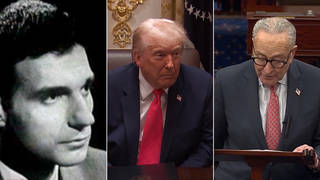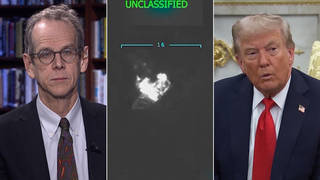
President Bush sent Congress a federal budget yesterday that some say reads like a hit list against almost every social program paid for by US taxpayers. It calls for the elimination of some 150 government programs. One out of every three of the targeted programs concerns education. [includes rush transcript]
Bush’s plan would slash aid to cities by one-third, eliminate health insurance for thousands of low-income families, reduce veterans’ medical benefits, cut funding for city cops and county sheriffs, wipe out child care subsidies for 300,000 families, trim funding for clean water and soil conservation and shutter dozens of programs for preschool children and at-risk youth. The budget also targets public housing, Medicaid and farmers.
In addition Bush is proposing to cut the budget of the Environmental Protection Agency by $450 million; to cut $100 million from a Bureau of Indian Affairs program that helps build schools and to cut $200 million for home-heating aid for the poor.
But Bush isn’t cutting back on all federal programs. The budget calls for a $19 billion increase in Pentagon spending. At a news conference in Washington, Bush spoke to reporters about his budget plan.
- President Bush, discussing his proposed budget on Feb. 7, 2005
- Jim Horney, Senior Fellow at the Center on Budget and Policy Priorities
Transcript
AMY GOODMAN: At a news conference in Washington, Bush spoke to reporters about his budget plan.
PRESIDENT GEORGE W. BUSH: I look forward to explaining to the American people why — why we made some of the requests that we made in our budget. I fully understand that sometimes it’s hard to eliminate a program that sounds good, but by getting people to focus on results — I’m saying to members of Congress, “Show us the results as to whether or not this program is working.”
AMY GOODMAN: President Bush speaking about his budget yesterday. We’re joined by Jim Horney, senior fellow at the Center for Budget Priorities in Washington, D.C. Welcome to Democracy Now!
JIM HORNEY: Thank you.
AMY GOODMAN: It’s good to have you with us. Well, first of all, your overall response to the President’s budget?
JIM HORNEY: I think what’s interesting about the budget is that the spending cuts that you were just talking about, which are quite severe cuts, we’re talking about cuts totaling $212 billion over the next five years for domestic discretionary, that is annually appropriated spending, which is virtually frozen at the current dollar level for five years, and by 2010, programs would have to be reduced by 16 percent. That’s a very deep cut.
Keep in mind that these cuts are proposed by the administration in the name of deficit reduction but one of the really interesting things is that over the next five years, according to the administration’s own numbers, they actually — the policies proposed in the budget actually add to the deficit about $29 billion dollars. And the reason for that, of course, is part of it is increases in Defense spending and increases in Homeland Security, but a very large reason for that is the tax cuts the President proposed, so the administration is saying we have big deficits, which is certainly true.
We need to do something about it but they would propose that all of the burden be put on domestic spending programs. These are programs that, in addition to providing just the day-to-day activities of the government, provide assistance to low and middle income Americans, people who really need the help the most. But this budget puts virtually all of the — puts all of the burden for so-called deficit reduction on — as I say it’s offset, more than offset by increased tax cuts and increased spending for Defense and Homeland Security.
It’s also interesting that some would claim that we have to cut domestic spending because that spending has been running away, and they would have you believe that such spending is responsible for the deficits that we have. That simply isn’t true. Any way you look at it, it’s not true.
If you look at the dramatic turnaround from when we had a surplus in 2000 to the deficits we have today, if you look at the change in spending and revenues as a percent of G.D.P., it’s clear that the reductions in revenues, which came from the tax cuts as well as changes in collections relative to the size of the economy, account for 71 percent of that change. It’s absolutely clear it’s not because spending has exploded that we have gone back into deficit, it’s because revenues have gone down.
Similarly, if you look at legislation enacted since 2001, the domestic part of the budget, which is the only thing that is being proposed for cuts in this budget account for only about one seventh of the cost of that legislation. 48 percent of the cost comes from tax cuts.
So, the administration is clearly showing that it has its priorities — but I think they’re backwards — in cutting programs, and programs that, the programs that will be cut are ones that really do help people in America that need help the most, cutting that while at the same time proposing big new tax cuts totaling $1.4 trillion over the next ten years. Having those big tax cuts but saying that we’ve gotta cut spending.
AMY GOODMAN: We’re talking to Jim Horney, the Senior Budget Fellow at the Center for Budget and Policy Priorities in Washington, D.C. Jim, I wanted to ask you about the Environmental Protection Agency. $450 million proposed cut. How significant is that?
JIM HORNEY: I have to admit I have not had a chance really to look at that. Yesterday in looking at the budget, I focused on the overall numbers and some of the programs like Medicaid, child care, other — Food Stamps that would be hurt. But from what I have seen about the proposals for the environment, particularly for E.P.A., it looks like that would be a very severe cutback in some of the efforts to reduce pollution in the country.
AMY GOODMAN: Do you think that some of these cuts aren’t as much to do with saving money, but as actually shifting policy by taking away money from regulators of companies involved with pollution?
JIM HORNEY: That’s certainly a possibility. Again, that’s not an area that I have any expertise in, but that wouldn’t be surprising. I think it’s also — as they say it’s clear that this is not really about reducing the deficit, it is about paying for tax cuts and then the choices that are made about where those cuts come certainly reflect the priorities of the administration of the programs that they care the most about, and the kinds of things they want to achieve.
AMY GOODMAN: What about the response right now, from the Republicans as well as the Democrats? How are people falling, on what sides here?
JIM HORNEY: I think it’s clear that there will be resistance to a number of the spending cuts the President proposed. You have seen that already, and — in answers not only from Democrats, but from influential Republicans on Capitol Hill.
The frightening thing, though, is that to the extent that the Congress as well — “We will accept your overall cuts. We think you should cut spending but we don’t like the particular ones, and ones that have gotten big reaction so far, for instance, proposed cuts in farm spending, some increased user fees for veterans’ health care”, variety of things, if the Congress says, “We’ll go along with your overall spending numbers , we’ll accept the discretionary spending caps that you have proposed for the next five years which assume that the domestic discretionary spending is frozen at the last year’s level,” but they refuse to go along with some of the specific cuts the President proposed, that means cuts in other areas that don’t have a strong constituencies could end up being cut by much more.
So, instead of, for instance, on Domestic Discretionary having a 16 percent cut across the board, you could end up with some programs being protected, and much deeper: 20, 25, 30 (percent) — even bigger cuts in other programs that don’t have the big constituencies on Capitol Hill.
AMY GOODMAN: How does a budget get approved? Is the process the same as, is it changing now under President Bush?
JIM HORNEY: The process is more or less the same. Essentially what happens is the President sends a budget up, and — it’s not a simple process, it’s not one where the budget legislation comes from the White House, laid down in Congress and Congress passes that or turns it down.
The budget is actually considered in a number of different steps. The first one is the budget committees and then House and Senate consider a budget resolution, which doesn’t actually implement any of the proposals. It simply sets a blueprint or plan for subsequent consideration of appropriation bills. In the past, it’s been 13 appropriation bills — they’re talking about reducing that this year — and then the legislation that has to implement tax cuts and changes in entitlement programs.
So, there are a number of steps all along the way, the President’s plan can be changed, and sometimes that may be for the better, from our perspective, sometimes not.
AMY GOODMAN: This issue of funding for police and firefighters slashed? This is a law and order administration, supposedly. And also veterans support.
JIM HORNEY: I think that does indicate that you have to look carefully at what is actually being done as far as the level of support is being provided rather than simply listen to rhetoric about what kinds of things you want to achieve. People have been concerned, for instance, about the claims from the administration about 'No Child Left Behind' and what they’re doing for education, but when people have looked at the actual funding that’s been proposed, they think sometimes that comes up short of the claims.
AMY GOODMAN: The issue of Food Stamps — expected as a $1 billion dollar cut in a $32 billion dollar program and the issue of Medicaid and child care. Can you talk specifically how this will affect people; how it will affect kids; affect women?
JIM HORNEY: It’s really interesting that we have these proposed cuts at a time when poverty has increased for three years in a row. The income distribution is getting more and more skewed away from low, moderate income people to high income. We have a record number of uninsured health — people who don’t have health insurance in this country. We have proposals here to cut Medicaid by $45 billion and States, as you know, are already scrambling to try to find funding for their share of Medicaid costs.
The cuts could almost certainly lead them to take steps that would leave even more people without adequate insurance. Food Stamps is a $1 billion cut. That translates into 200,000 to 300,000 families being terminated. The administration has proposed freezing child care funding for five years. According to their numbers, that means 300,000 people will be terminated.
So, at a time when the trends and the society and economy are against people who are most in need and where high income people have seen their incomes go up and their taxes cut, here we have more cuts for programs that are helping the people who really need it.
AMY GOODMAN: Finally, the Federal subsidies for Amtrak, they’re considering cutting all of them?
JIM HORNEY: That’s the proposal. This administration has not favored funding for Amtrak. This is one where there are powerful supporters of Amtrak in the Congress, and not at all clear that the administration’s proposal will be enacted.
AMY GOODMAN: Well, Jim Horney, I want to thank you very much for being with us. A Senior Fellow at the Center for — for the Center for Budget and Policy Priorities. Thanks for joining us.
JIM HORNEY: Thank you for having me.












Media Options